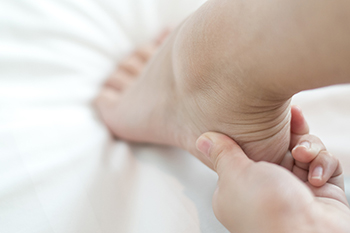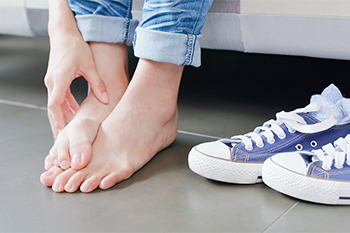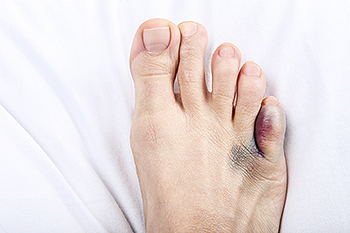

A common condition that can affect children and young teenagers who actively participate in sporting activities is known as Sever’s disease. This is an ailment that affects the heels, and can develop as a result of a heel growth spurt. The heel pain is caused by tight calf muscles or Achilles tendon, and the pain may increase when their chosen activities are pursued. You may notice your child is limping, walking on their toes, or experiencing swelling surrounding the heel. These symptoms may be indicative of Sever’s disease. It is beneficial to wear shoes that fit correctly, and this may help the affected foot to feel better. Effective treatment starts with stopping the activity that caused the condition. It is also important to elevate the foot as often as possible. The average recovery time for Sever’s disease is approximately 2-3 months. If your child has these symptoms, it is advised that you consult with a podiatrist who can effectively diagnose and offer treatment solutions.
Sever's disease often occurs in children and teens. If your child is experiencing foot or ankle pain, see Dr. Alan J. Spector from Shore Podiatry. Our doctor can treat your child’s foot and ankle needs.
Sever’s Disease
Sever’s disease is also known as calcaneal apophysitis, which is a medical condition that causes heel pain I none or both feet. The disease is known to affect children between the ages of 8 and 14.
Sever’s disease occurs when part of the child’s heel known as the growth plate (calcaneal epiphysis) is attached to the Achilles tendon. This area can suffer injury when the muscles and tendons of the growing foot do not keep pace with bone growth. Therefore, the constant pain which one experiences at the back of the heel will make the child unable to put any weight on the heel. The child is then forced to walk on their toes.
Symptoms
Acute pain – Pain associated with Sever’s disease is usually felt in the heel when the child engages in physical activity such as walking, jumping and or running.
Highly active – Children who are very active are among the most susceptible in experiencing Sever’s disease, because of the stress and tension placed on their feet.
If you have any questions, please feel free to contact our office located in Point Pleasant, NJ . We offer the newest diagnostic and treatment technologies for all your foot and ankle injuries.

Athlete’s foot, also known as tinea pedis, is the most common fungal infection that affects the feet. It is common in older children, and it might occur in one or both feet. This fungus grows best in warm, moist areas of the skin and between the toes. Someone with this affliction will experience red, moist, scaly, and cracked skin that can be itchy and peeling between the toes. Sometimes they will find small blisters on the bottoms and sides of the feet. This might also be accompanied by an unpleasant odor and can come back repeatedly. Home treatment of athlete’s foot includes washing and drying the child’s feet daily, moisturizing them, using antifungal powders and lotions that can be purchased over-the-counter, wearing clean socks daily, wearing shoes that breathe, not sharing shoes or socks with others, rotating shoes between wearing them, and making sure to wear footwear in public spaces like community showers, gyms, or swimming pools. If the condition is not healing, an infection develops, the feet swell, there is pus or pain, consult with a podiatrist for a more effective treatment for your child’s athlete’s foot.
Making sure that your children maintain good foot health is very important as they grow. If you have any questions, contact Dr. Alan J. Spector of Shore Podiatry. Our doctor can provide the care you need to keep you pain-free and on your feet.
Keeping Children's Feet Healthy
Having healthy feet during childhood can help prevent medical problems later in life, namely in the back and legs. As children grow, their feet require different types of care. Here are some things to consider...
Although babies do not walk yet, it is still very important to take care of their feet.
Avoid putting tight shoes or socks on his or her feet.
Allow the baby to stretch and kick his or her feet to feel comfortable.
As a toddler, kids are now on the move and begin to develop differently. At this age, toddlers are getting a feel for walking, so don’t be alarmed if your toddler is unsteady or ‘walks funny’.
As your child gets older, it is important to teach them how to take care of their feet.
Show them proper hygiene to prevent infections such as fungus.
Be watchful for any pain or injury.
Have all injuries checked by a doctor as soon as possible.
Comfortable, protective shoes should always be worn, especially at play.
If you have any questions please feel free to contact our office located in Point Pleasant, NJ . We offer the newest diagnostic and treatment technologies for all your foot and ankle needs.

Participating in athletic activities account for approximately 50% of broken or dislocated ankles. The remaining half of the population can break their ankle from pursuing daily activities which can include shopping, walking, and traveling. It can range from a hairline crack to a full blown fracture, and this can cause severe pain and discomfort. The ankle has three sections, consisting of the tibia, the fibula, and the talus bones. There are a total of 26 bones in each foot, and are surrounded by numerous tendons, ligaments, and muscles. In a severe fracture, one or more of the bones break, and may also affect the adjoining ligaments. Ankle function is often affected when any of these bones are broken. There are three types of ankle fractures that can occur. The bump on the inside of the ankle is called medial malleolus, and can become fractured from direct trauma. This often indicates a long recovery time. The bump on the outside of the ankle is created by the fibula, and may be injured as a result of a stress fracture. A bimalleolar fracture happens when both sides of the ankle become broken, and this can occur from a traumatic event such as a car accident. If you have broken your ankle, it is strongly advised that you consult with a podiatrist who can determine what the best course of treatment is for you.
Broken ankles need immediate treatment. If you are seeking treatment, contact Dr. Alan J. Spector from Shore Podiatry. Our doctor can provide the care you need to keep you pain-free and on your feet.
Broken Ankles
A broken ankle is experienced when a person fractures their tibia or fibula in the lower leg and ankle area. Both of these bones are attached at the bottom of the leg and combine to form what we know to be our ankle.
When a physician is referring to a break of the ankle, he or she is usually referring to a break in the area where the tibia and fibula are joined to create our ankle joint. Ankles are more prone to fractures because the ankle is an area that suffers a lot of pressure and stress. There are some obvious signs when a person experiences a fractured ankle, and the following symptoms may be present.
Symptoms of a Fractured Ankle
If you suspect an ankle fracture, it is recommended to seek treatment as soon as possible. The sooner you have your podiatrist diagnose the fracture, the quicker you’ll be on the way towards recovery.
If you have any questions, please feel free to contact our office located in Point Pleasant, NJ . We offer the newest diagnostic and treatment technologies for all your foot care needs.

Sore feet can be common as the aging process occurs. It is beneficial to frequently perform simple foot stretches and exercises, and this can promote increased flexibility and range of motion. An effective stretch is done by sitting in a chair, and while keeping the feet flat on the floor. Start by raising the toes off the floor several times, followed by the heels, and hold for a few seconds. The big toe can be stretched by bringing one foot up to rest on the knee of the other leg, and gently stretching the big toe up and down. This can help to maintain a wide range of motion in the toe, in addition to relieving pain from wearing tight shoes. All the toes can receive an adequate stretch when a toe splay is practiced. This is accomplished by keeping the heel on the ground, and moving all the toes at once up and down. There are many additional benefits to stretching the feet, and it is suggested that you speak with a podiatrist who can guide you toward the right stretching techniques.
Why Stretching Is Important for Your Feet
Stretching the feet is a great way to prevent injuries. If you have any concerns with your feet consult with Dr. Alan J. Spector from Shore Podiatry. Our doctor will assess your condition and provide you with quality foot and ankle treatment.
Stretching the Feet
Stretching the muscles in the foot is an important part in any physical activity. Feet that are tight can lead to less flexibility and make you more prone to injury. One of the most common forms of foot pain, plantar fasciitis, can be stretched out to help ease the pain. Stretching can not only ease pain from plantar fasciitis but also prevent it as well. However, it is important to see a podiatrist first to determine if stretching is right for you. Podiatrists can also recommend other ways to stretch your feet. Once you know whether stretching is right for you, here are some excellent stretches you can do.
It is best to go easy when first stretching your foot and work your way up. If your foot starts hurting, stop exercising to ice and rest the foot. It is advised that you then see a podiatrist for help.
If you have any questions, please feel free to contact our office located in Point Pleasant, NJ . We offer the newest diagnostic and treatment technologies for all your foot care needs.

Pain in the fifth toe, commonly referred to as the pinky toe, can be quite problematic. Although the pinky is the smallest of all the toes on the feet, pinky toe pain can be uncomfortable nonetheless. Since this toe is located on the outside of the foot, the pinky toe can be especially prone to stubbing and injuries. If you are experiencing pain in the pinky toe, there could be any number of causes. First, you might have broken or fractured the pinky toe. Broken toes will sometimes release a popping sound when impacted. X-rays might be needed to analyze the toe and its fracture. Another potential cause of pinky toe pain is ill-fitting footwear that makes the pinky toe rub up against the shoe. Lastly, pinky toe pain can be caused by the development of a corn. Similar to a thick, hardened callus, corns on the pinky toe can be painful when they are rubbed against the inside of a pair of shoes. Pain in the pinky toe is no joke — it is suggested you see a podiatrist who can help you address the problem.
Toe pain can disrupt your daily activities. If you have any concerns, contact Dr. Alan J. Spector of Shore Podiatry. Our doctor can provide the care you need to keep you pain-free and on your feet.
What Causes Toe Pain?
Most severe toe pain is caused due to a sports injury, trauma from dropping something heavy on the toe, or bumping into something rigid. Other problems can develop over time for various reasons.
Toe pain can be caused by one or more ailments. The most common include:
When to See a Podiatrist
Diagnosis
In many cases the cause of toe pain is obvious, but in others, a podiatrist may want to use more advanced methods to determine the problem. These can range from simple visual inspections and sensation tests to X-rays and MRI scans. Prior medical history, family medical history, and any recent physical traumatic events will all be taken into consideration for a proper diagnosis.
Treatment
Treatments for toe pain and injuries vary and may include shoe inserts, padding, taping, medicines, injections, and in some cases, surgery. If you believe that you have broken a toe, please see a podiatrist as soon as possible.
If you have any questions please feel free to contact our office located in Point Pleasant, NJ . We offer the newest diagnostic tools and technology to treat your foot and ankle needs.